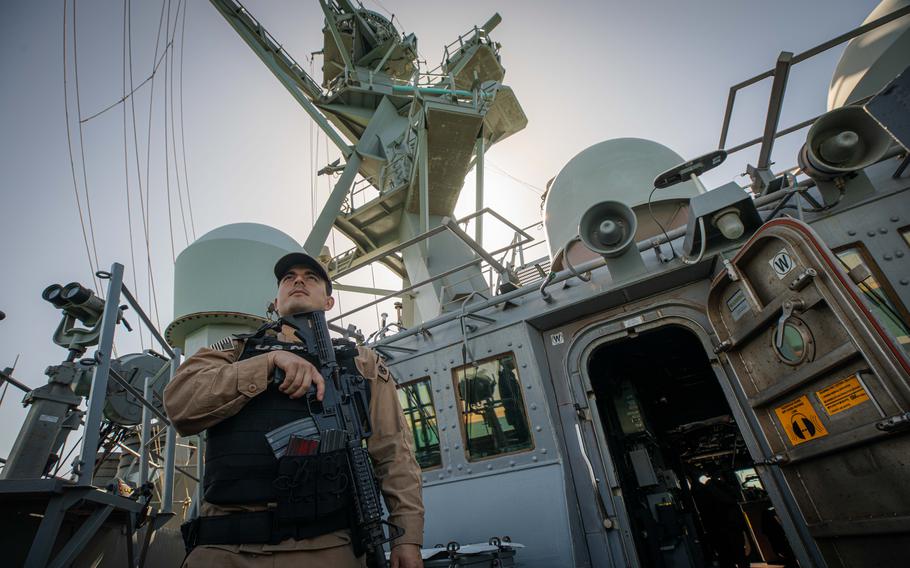
Lt. j.g. Andres Andrade stands watch aboard the Arleigh Burke-class guided-missile destroyer USS Carney during a transit of the Suez Canal, Nov. 6, 2023. The USS Carney shot down drones and a missile launched by Yemen’s Houthi rebels toward it in the Red Sea, officials said. (Aaron Lau/U.S. Navy)
The Iran-backed Houthi rebel group’s recent drone and missile attacks on commercial ships in the Red Sea is another clear indication that despite ramped up airstrikes by the United States and allies in Yemen, the terror group has no plans to stop targeting merchant vessels in the region.
Many experts warn that any extended engagement could bog down U.S. forces in a years-long quagmire against an agile enemy that is “very comfortable operating in a wartime environment.”
To successfully thwart these attacks without a protracted campaign, U.S. military leaders must harness emerging technologies that can give the U.S. and its allies the strategic upper hand in the Red Sea. To fully appreciate how technologies such as autonomous surface vehicles and advanced buoy systems can help combat this terror group, we must first understand the difficulty in combating groups like this.
From the Vietnam War to the wars in Afghanistan and Iraq, traditional militaries have historically struggled to combat guerrilla insurgencies given the latter’s ability to attack their foes, fade into the shadows, and never engage in traditional symmetric warfare.
The Houthis’ decade-long fight with the Saudis along with their recent attacks on commercial ships show that they have mastered this type of irregular warfare. They are experts at hiding missiles and drones in isolated inlets along the Red Sea coast or inside dense urban areas, launching attacks from the backs of trucks before scooting away, and building vast underground caches of missiles and one-way attack drones.
While it may seem counterintuitive, many experts argue that the Houthis’ home base in war-torn Yemen plays to the group’s advantage. As Abdullah Baabood, an Omani senior nonresident scholar at the Carnegie Middle East Center, said, the Houthis “calculate that there aren’t many valuable targets that the U.S. and U.K. can strike, as the country is already in ruins.”
Given these advantages, America and its allies can’t defeat the Houthis with overwhelming military force alone, but instead must use their technological advantage to protect the Red Sea’s valuable shipping lanes and neutralize the Houthi threat.
In recent years, there have been huge strides in the development of unmanned, autonomous systems to support many missions and capabilities. There are now monitoring and detection capabilities that provide critical intelligence to maritime forces and security and perimeter defenses at ports that ensure vessels aren’t proverbial sitting ducks when docked.
The Navy, along with the other branches of the U.S. military, has taken notice. Operation Prosperity Guardian already employs drones to increase patrols in the Red Sea and the Gulf of Aden, while the new Task Group 59.1 is concentrated on deploying unmanned systems alongside manned operators to bolster maritime security across the Middle East region.
The Marines have even coopted the Houthis’ use of commercial radar systems to make mobile trackers for use in the Baltic Sea region.
It’s a good sign that the Navy sees major value in augmenting strike groups with unmanned and autonomous systems that balance its advanced weaponry, but more investment is needed. For example, military leaders must investigate autonomous surface vehicles and advanced buoy systems that can join with data from undersea, air and ground systems to give commanders a complete view of a region and identify anomalies and threats quickly and effectively.
This is an incredibly important moment in the Red Sea — which encompasses an area almost 15,000 square miles larger than California and sees between $3 and 9 billion worth of goods pass through it every day. These same unmanned and autonomous systems can also be used in areas such as the South China Sea and other regions that extend far beyond the current battle space.
To protect global shipping, the principle law of freedom of navigation, geopolitical stability, and bring some semblance of peace to the region, the U.S. needs to think outside the box to combat the Houthis and embrace emerging technologies.
Joe “Digger” DiGuardo, a retired U.S. Navy rear admiral, is the senior director of government strategy at Ocean Power Technologies and the principal firm DiggerWorks Consulting LLC, which represents clients that provide systems, platforms and components supporting the protection of critical U.S. assets in dynamic and contested environments.